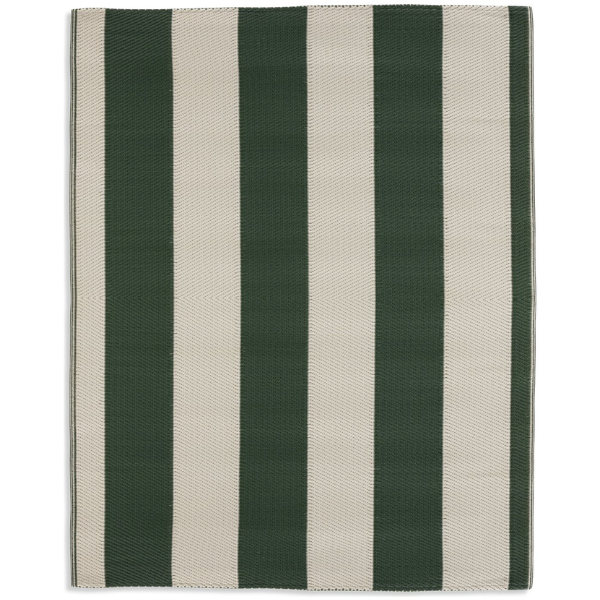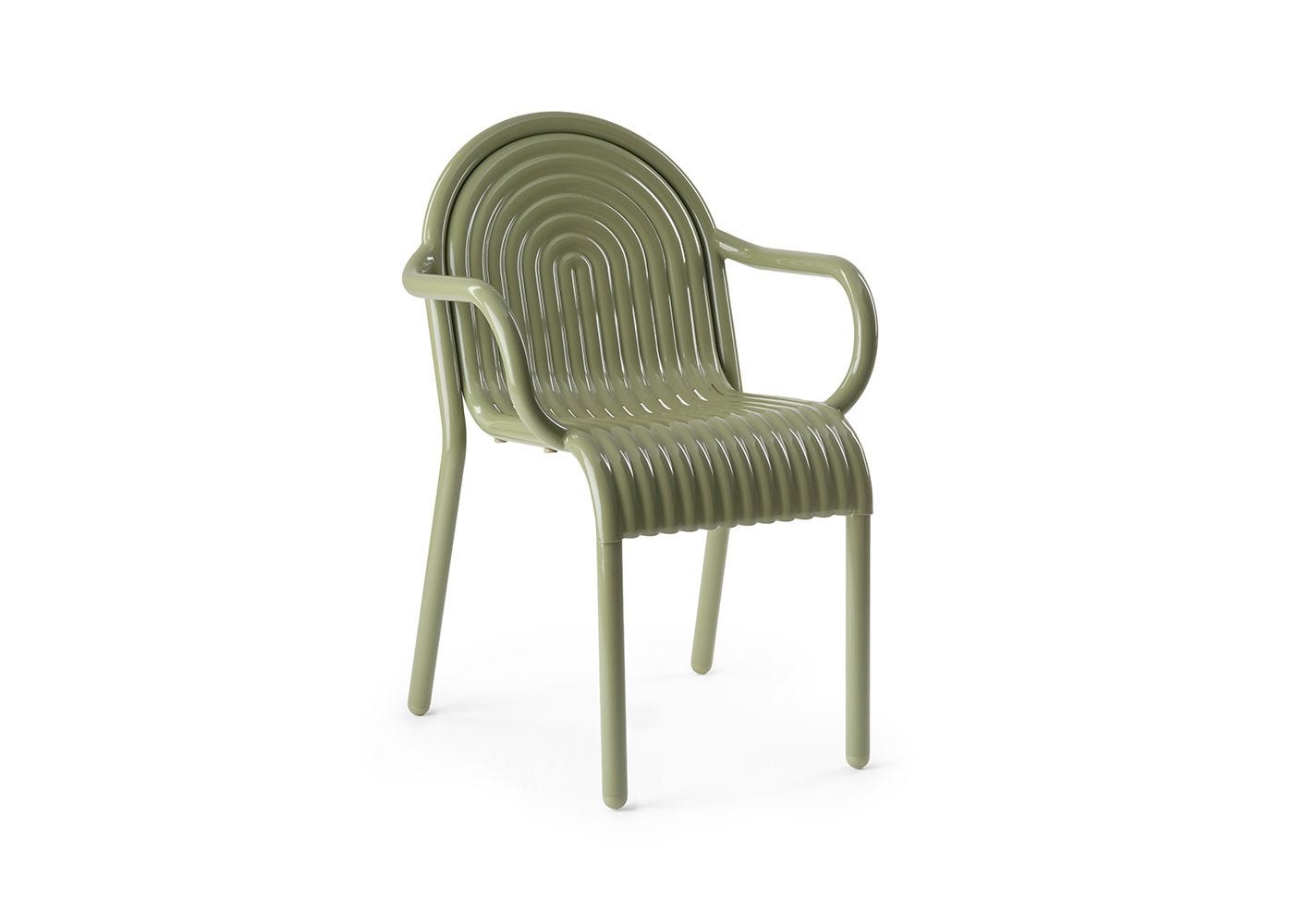Outdoor Dining Ideas — 9 Inspiring Ways to Upgrade Your Al Fresco Setup
Designers spill the subtle styling choices that make all the difference for ultimate outdoor entertaining


Dinner is served — al fresco, obviously — but no one’s sitting down. You could convince yourself they’re just deep in conversation, but if we're being honest, the setup looks temporary. The chairs are cold. The table feels like it was borrowed from a rental house that hasn’t been updated since the aughts. And everything seems vaguely afraid of the next storm. Not exactly built for long, wine-soaked meals.
We want more from our outdoor dining spaces now — the same things we expect indoors: atmosphere, permanence, possibly a little theater, which is why oversized silhouettes, sculptural shapes, and pieces that tell stories are defining how we design and decorate our al fresco havens this year.
From where to put your outdoor dining setup — whether you have an outdoor kitchen or not — to what to buy and what they should be made of, we tapped designers and tastemakers for outdoor dining ideas that actually work, and feel like a true extension of your home. Ahead, the pieces (and placements) that’ll have guests seated before you even call them over.
1. Dine Under a Pergola
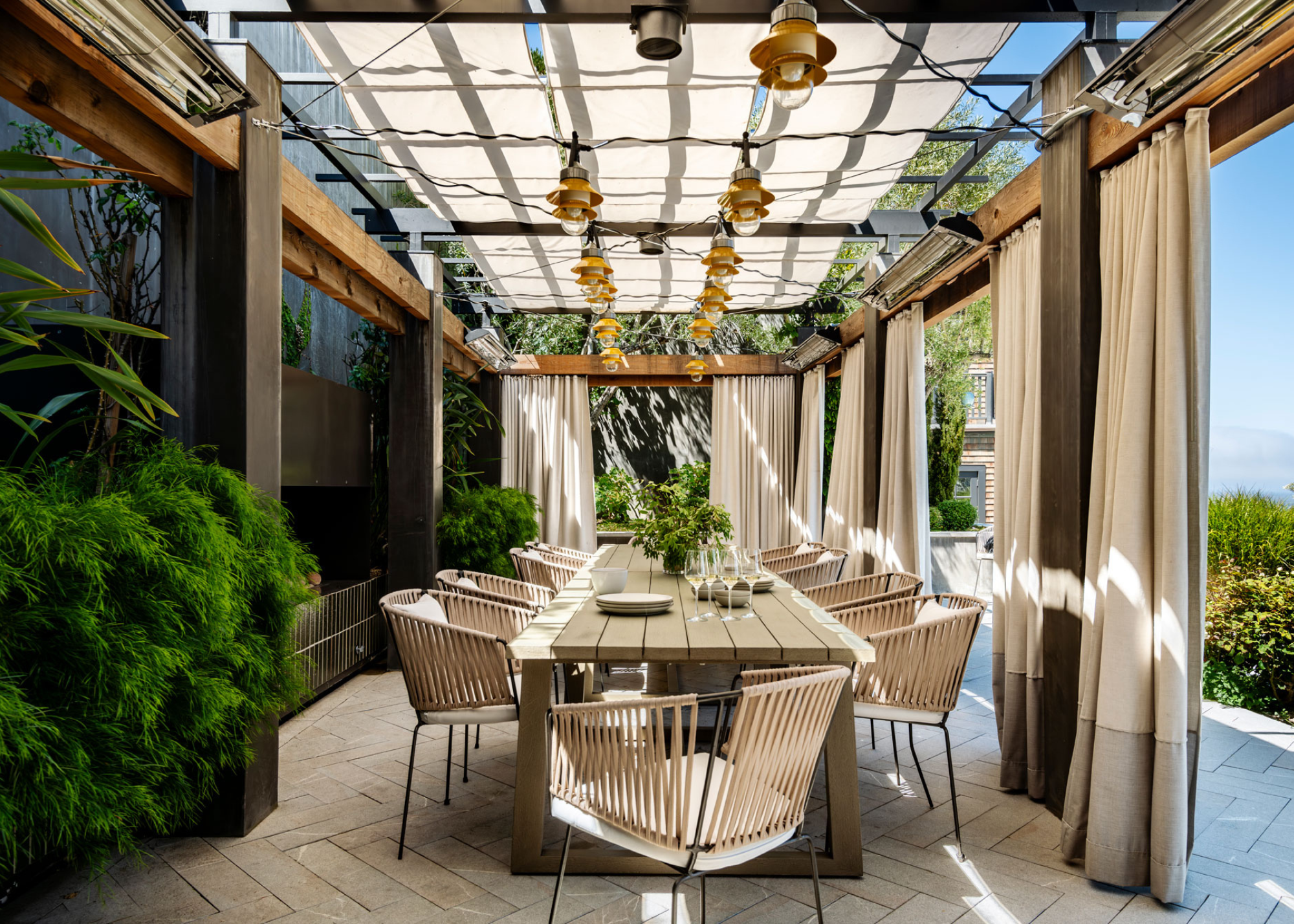
Leave it open, or create some shade of your own with fabric drapery, which stands as a soft, simple way to add atmosphere.
"A pergola or arbour instantly elevates an outdoor dining space,” says Larry Walshe, founder of luxury event atelier Larry Walshe Studios. They’re relatively simple to install, which might feel suspicious, but choosing one in natural oak, powder-coated iron, or architectural aluminium ensures it’ll last (and look intentional).
Because pergolas are open-roofed and structurally pared back, they invite a bit of creativity. Use paint to tie the framework into your tablescape, or, “If you can add climbing plants to soften it, even better,” says Jordan Neman, co-founder and creative director of House of Leon. Larry recommends jasmine or wisteria specifically — “to wrap around the structure to add softness and scent.” Just place a pot at the base, give it time, and let the growth do its thing.
Plant Theory's White Japanese Wisteria on Amazon is ready to plant and will look beautiful grown over and around your pergola.
For something more dressed, drape sheer linen or voile from the beams — “which can create an almost ethereal canopy effect, reminiscent of a boutique hotel in the Mediterranean,” says Larry.
The Livingetc newsletters are your inside source for what’s shaping interiors now - and what’s next. Discover trend forecasts, smart style ideas, and curated shopping inspiration that brings design to life. Subscribe today and stay ahead of the curve.
Interior designer Laura Roberts did exactly that for a client, adding a boho edge and a bit of privacy. “The client was looking to have an intimate outdoor dining experience,” she explains. “The sheer curtain allows for the dining area to be closed off from the rest of the yard, while still allowing light into the space. This elevates the dining area to feel more intimate and elegant.”
These BONZER Sheer Outdoor Curtains on Amazon are waterproof and have a glowing 4.5 stars after over 1,600 reviews.
Larry Walshe is the founder of Larry Walshe Studios, an award-winning floral and event design house known for its theatrical detail, as well as its work with celebrities, royal households, and global luxury brands.
2. Match (Or Contrast) Surroundings With Color

When nature doesn’t provide the backdrop, add a jolt of personality yourself — especially useful for patios and city spaces.
Some of us live in the countryside. Others overlook mid-century towers from a city patio. We can’t all reference rolling green hills, just like we can’t all design around brutalist concrete. When it comes to paint color ideas or broader color palettes for outdoor dining, the move is simple: either echo your surroundings, or go completely against them. The middle ground is actually the danger zone.
“We find that colorways that emphasise nature work the best for complementing outdoor spaces — obviously warm wood, but also black, gray, and metal really bring out green leaves and the colors of flowers,” says Bo Hellberg, CMO at Swedish outdoor furniture specialists Grythyttan. “These shades are calm and timeless and make the space connect to the surrounding garden, greenery, and nature.”
That said, context matters. “In a cityscape outdoor area, it’s different, and we are seeing a trend for more bold colors,” he adds. “From soothing greens, mellow yellows, and rustic reds, these shades fit seamlessly into any outdoor space, while adding a touch of high design.”
For Jordan Neman, who’s based in Los Angeles — lots of beaches and canyons — the surrounding palette takes the lead. “I usually lean into natural tones that already work with the landscape,” he says. “Warm creams, rust, olive green, muted charcoal. I stay away from anything super bright or overly cool since it can feel out of place.”
Jordan Neman is the co-founder and creative director of House of Leon, a Los Angeles–based furniture brand rethinking design for the next generation. Alongside his twin and co-founder, Steven Neman, he creates sculptural, design-forward pieces at accessible price points.
3. Try an Outdoor Rug

Define your outdoor dining area with a rug, which is easily the lowest-effort, highest-impact move on the list.
In 2025, the goal with outdoor setups — dining included — is to make them feel less like an afterthought and more like an extension of the interior. One of the simplest ways to get there? Add an outdoor rug.
[A rug] “under the table helps ground everything and makes it feel more intentional,” says Jordan Neman, co-founder and creative director of House of Leon.
“Rugs are a must,” agrees Larry Walshe. “Outdoor rugs in jute, polypropylene, or woven recycled materials help delineate the dining area and provide a grounding base.” He recommends going for contrast, whether through texture or pattern, “to layer visual interest without competing with the natural surroundings.”
It’s a low-lift move with a high return. In just seconds, the patio reads more like a room.
4. For Lighting, Go Cordless
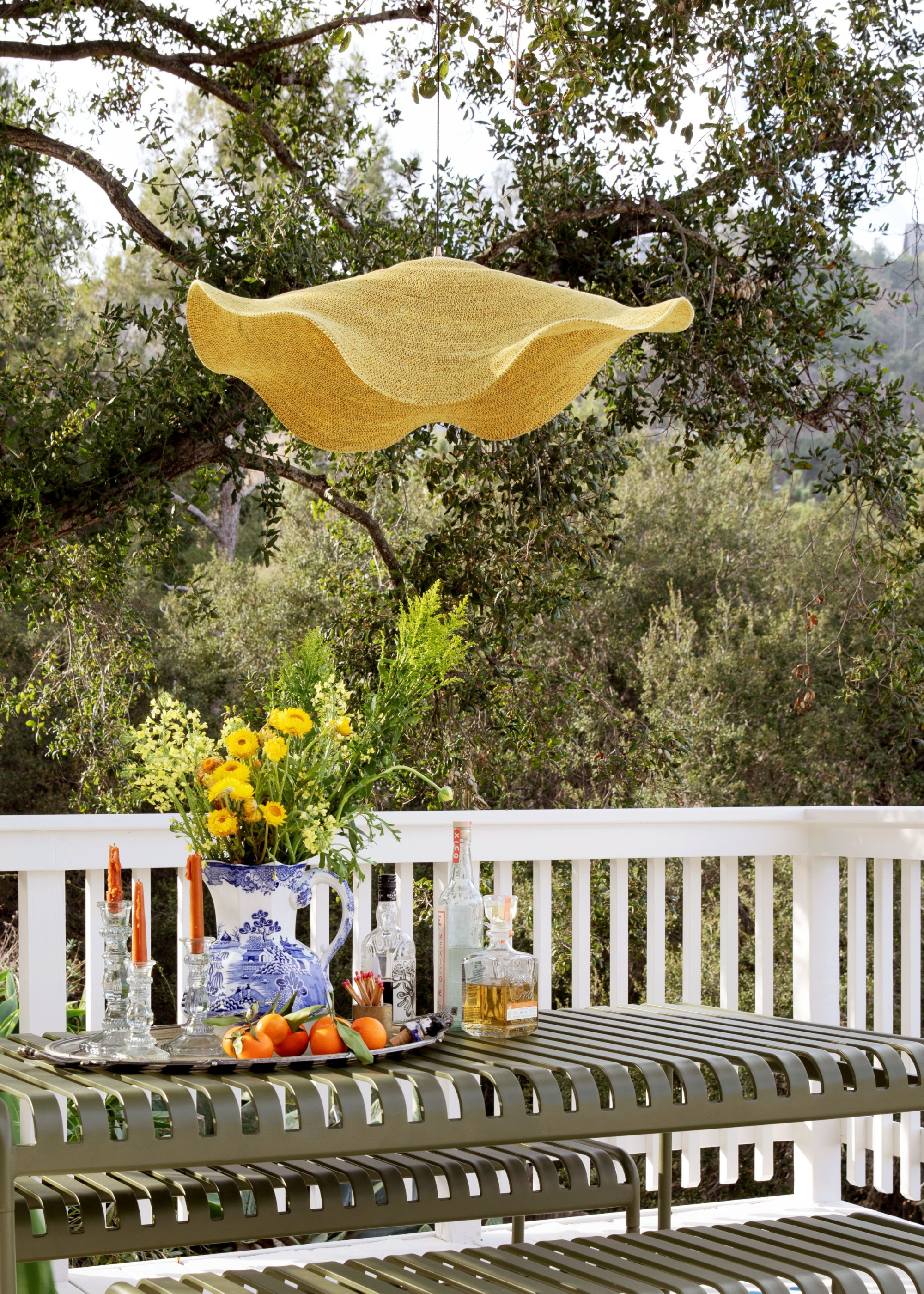
Cordless lighting, like this yellow pendant from the Pooky x Novogratz collab, lets you hang statement pieces from anywhere — even trees — and gives your setup the ambient light it deserves.
By now, we’ve collectively agreed on the perils of the “big light.” If your interiors are already layered with soft, strategic lighting, why wouldn’t you do the same outdoors? The usual excuse: cords. Followed closely by: electricians.
The good news? There’s an ever-growing selection of cordless, rechargeable outdoor dining lighting ideas — meaning ambient glow is no longer limited by outlets (or permits).
“Cordless lighting is definitely preferable — it keeps the setting clean and versatile,” says Jordan Neman. “For overhead options, if you have structure, woven pendants, or linen lanterns on dimmers can transform the mood completely. And don’t underestimate the power of candlelight. I like mixing pillar candles in glass hurricanes with small ceramic oil lamps to create uneven, organic light.”
And it's not just rechargeable pendant lighting that we love; the best rechargeable lamps make outdoor dining a dream, for both versatility and ambiance.
Larry Walshe takes a layered approach. “I often use low uplighting on nearby trees or architectural features. It creates layers and adds depth to the scene without overwhelming the table itself,” he notes, favoring a balance of ambient and accent sources.
“Anything dimmable is a bonus,” Jordan adds. Brands like Pooky, whose recent collaboration with The Novogratz includes rechargeable lanterns and pattern-heavy lamps in everything from floor to table sizes, are meeting the moment.
“Just make sure to check brightness and battery life,” Larry adds. “It should last through dinner and digestifs.”

This outdoor rechargeable pendant light from Newgarden is weatherproof, making it perfect to use in your outdoor dining setup. Its 3-meter-long cord can be tied to any spot for ultimate garden lighting flexibility. Just turn it on with its remote and enjoy up to 20 hours of ambient light.
5. Be Clever With Placement
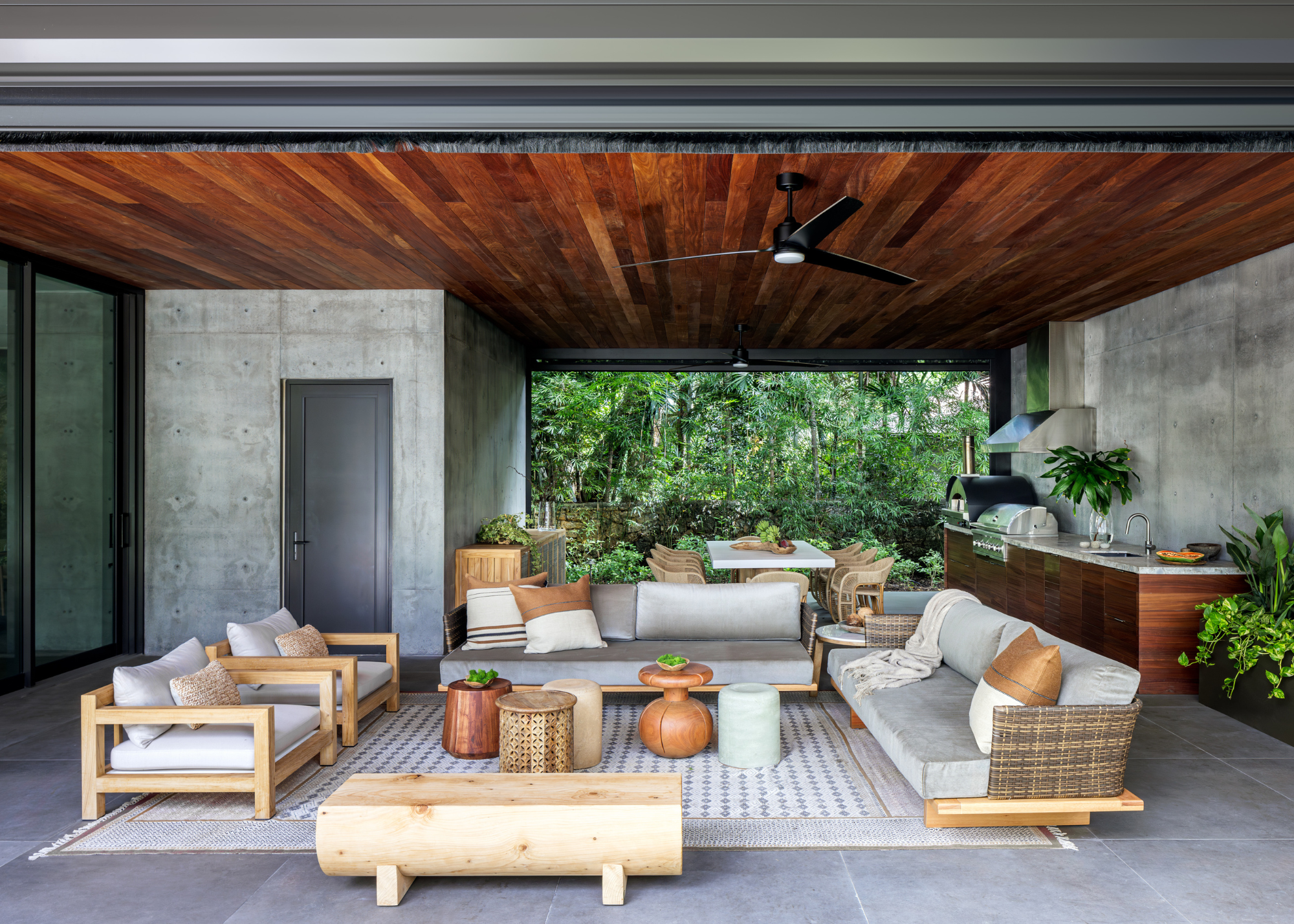
The same real estate logic applies outdoors: if you’re cooking outside, don’t make it a trek. Keep the dining table close.
Where you place your furniture matters as much as what you choose. “Perhaps you want a space for lounging in the sun, cozying up with throws in the evening, or supporting a BBQ,” says Jonny Brierley, CEO of Moda Furnishings. “Maybe even a spot for watching films on an outdoor screen.” The same way you’d plan a room indoors, consider how you want the space to function.
“Think about placing furniture in different parts of the garden for different purposes,” says Grythyttan's Bo Hellberg. It’s not just about layout — it’s about flow, light, and how the space gets used. Your outdoor dining ideas should be considered with just as much thought as your outdoor living room ideas — just as you would for these spaces inside the home.
Avoid direct sun in dining areas, or bring in a parasol. “A relaxing lounge set-up should have a nice view or overlook a part of the garden you’re proud of,” Bo adds. Unless you only eat after dark (and plan to avoid inclement weather at all costs), some sort of cover — for sun, rain, or just the illusion of resort living — is worth having.
“Never forget about shade,” says Larry Walshe. “Too much sun during lunch can ruin an otherwise beautiful setup.”
Also consider foot traffic. “If you have a long, narrow garden, you might want to zone it. Wider gardens can benefit from multiple access points,” Jonny explains. Dining spaces near driveways or pool pump rooms? “A no,” says Larry. “Outdoor dining should feel like a destination, not an afterthought.”
6. Don't Be Afraid to Explore With Your Furniture
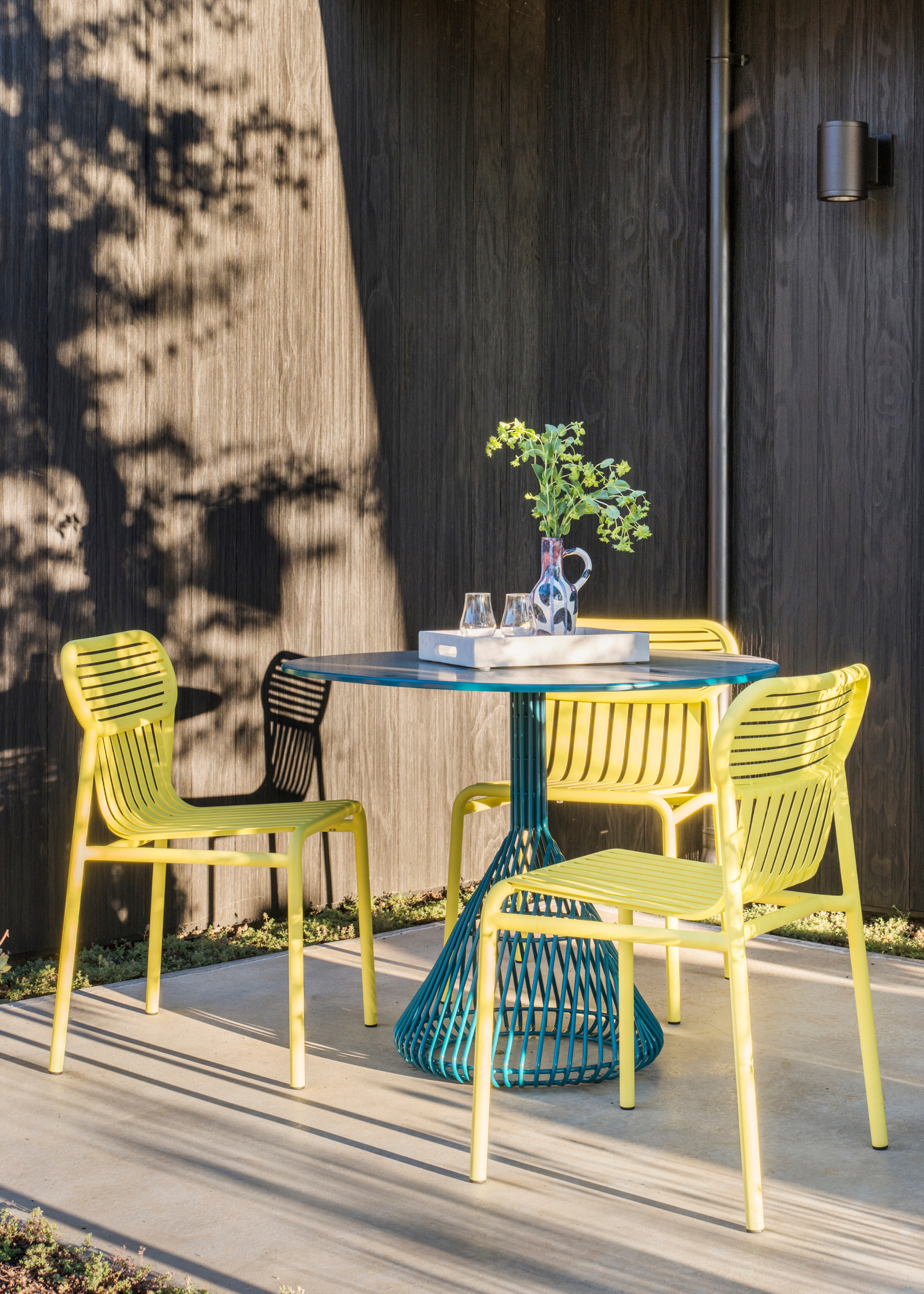
Daring to be different is better than being caught with the same mass-produced dining set as everyone else.
Resist the urge to spring on the big-box seven-piece dining set when hunting for the best garden furniture. It technically works, sure — but your eyes, your guests, and your Instagram Story deserve better.
“Avoid matchy-matchy furniture sets — they lack personality and often feel commercial,” notes Larry Walshe, and these are one of the tacky and dated outdoor furniture mistakes you need to avoid.
Speaking of, “Plastic tablecloths, synthetic flowers, and overly bright LED lights are also a hard no," he adds. Instead, focus on incorporating furniture and decor that will elevate your outdoor area.
7. Break Up Hard Textures With Soft Fabrics
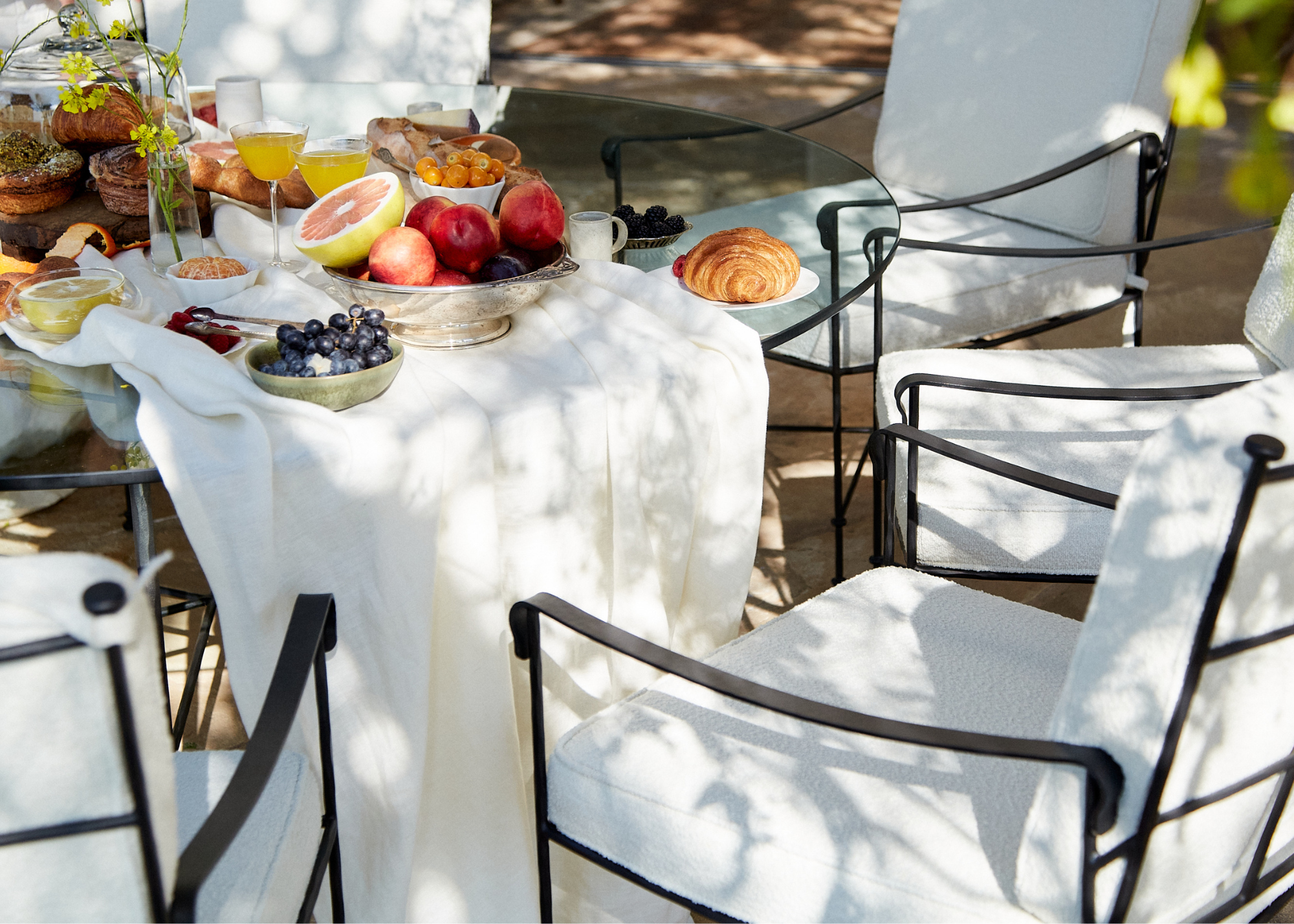
Outside still calls for cozy. Upholstery in outdoor bouclé, like House of Leon’s, gives you texture that reads indoor while holding up to the elements.
The best outdoor seating is the kind you actually want to sit in. Too much exposed metal or bare plastic, and the whole setup starts to feel… tense.
“Break up opposed textures such as stone and wood with soft fabrics,” says Jordan Neman. For him, comfort is the priority, but form still matters. “I always look for pieces that still look great even when the cushions are off or tucked away,” he says. “Outdoor cushions get stored a lot, so the base design needs to hold its own. The goal is for the setup to feel intentional, whether it’s fully dressed or stripped back.”
Bo Hellberg sees the same garden seating issue: “A mistake we often see is putting style ahead of practicality. Outdoor furniture needs to be sturdy and comfortable, not just pretty.”
Larry Walshe takes it further. “Don’t skimp on comfort,” he advises. “Go for plush, upholstered seat pads and back cushions in performance fabrics that feel every bit as luxurious as their indoor counterparts. Layer with throws in textured weaves — bouclé, brushed cotton, or light wool — for cooler evenings. It’s these tactile touches that really elevate the experience.”

French Connection's Cadley Eco Textured Throw is a stylish piece to bring out into your outdoor dining setup when it gets a little cooler come evening time — or else just to style over a chair or garden sofa to complete your outdoor setup.
8. When in Doubt, Accent Upwards
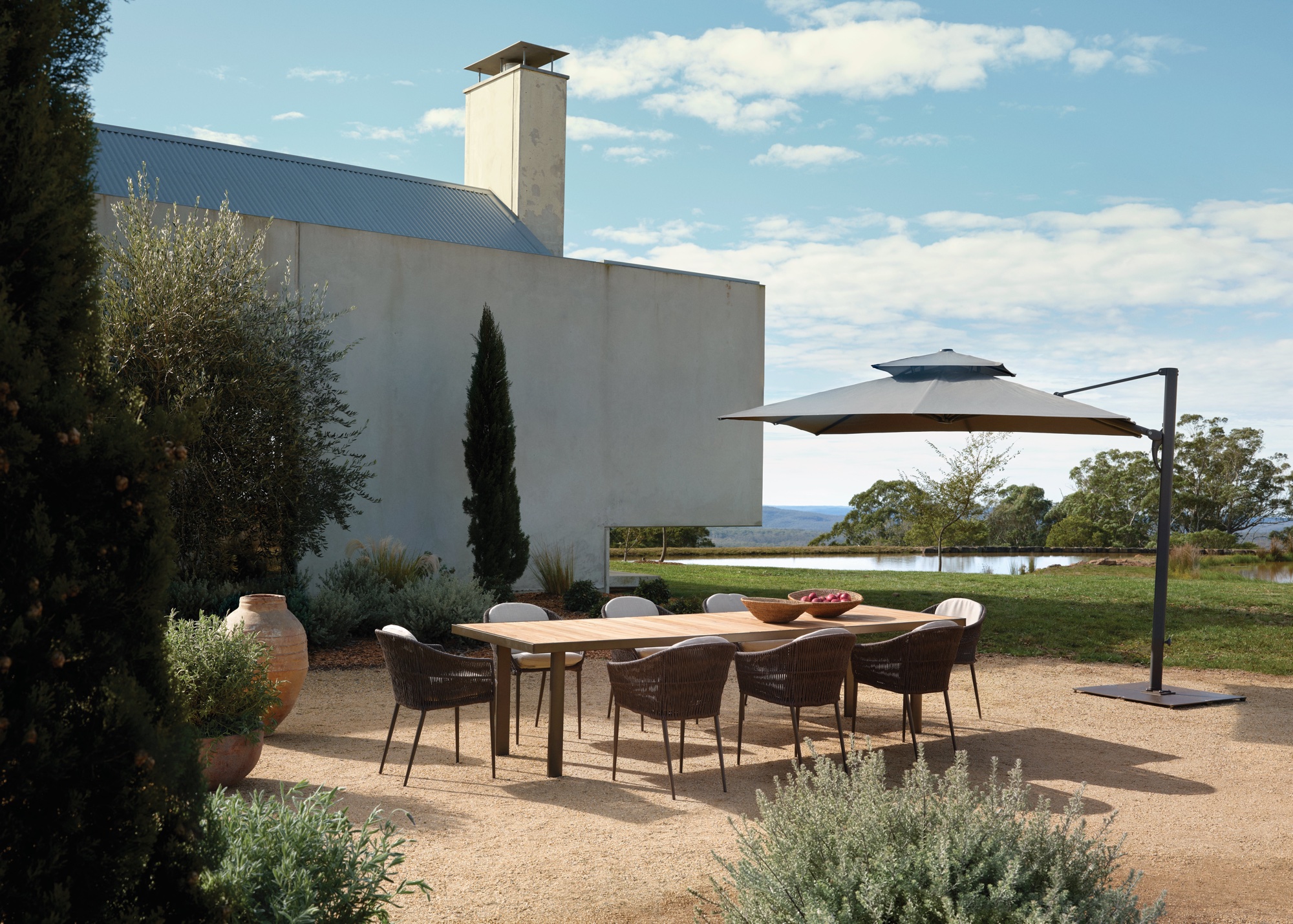
Zone the outdoor dining space with accents that draw guests' attention upwards.
Wherever possible, add dimension by introducing verticality. You can get creative here: “Incorporate tall planters or sculptural urns on plinths to draw the eye upward and frame the dining scene,” recommends Larry Walshe.
You can even fill them with fragrant herbs — lavender, rosemary, thyme — so they release scent as guests brush past.
Lighting counts, too. “Lanterns placed at different heights — on the floor, on tables, and even suspended — create a tiered glow that mimics the nuance of indoor lighting,” Larry adds.
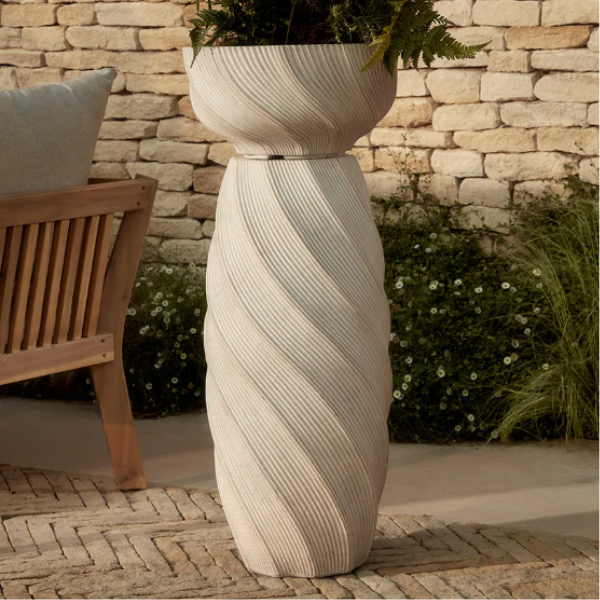
Size: H 70 x Dia. 32cm
This decorative spiral plinth from Cox and Cox is made from polymagnesium and pairs beautifully with its small spiral cream planter, which sits on top of the plinth perfectly (as shown) for a layered look and extra height. The natural, minimalist design would add style to any modern garden.
9. Design Around a Central Firepit, or Fireplace
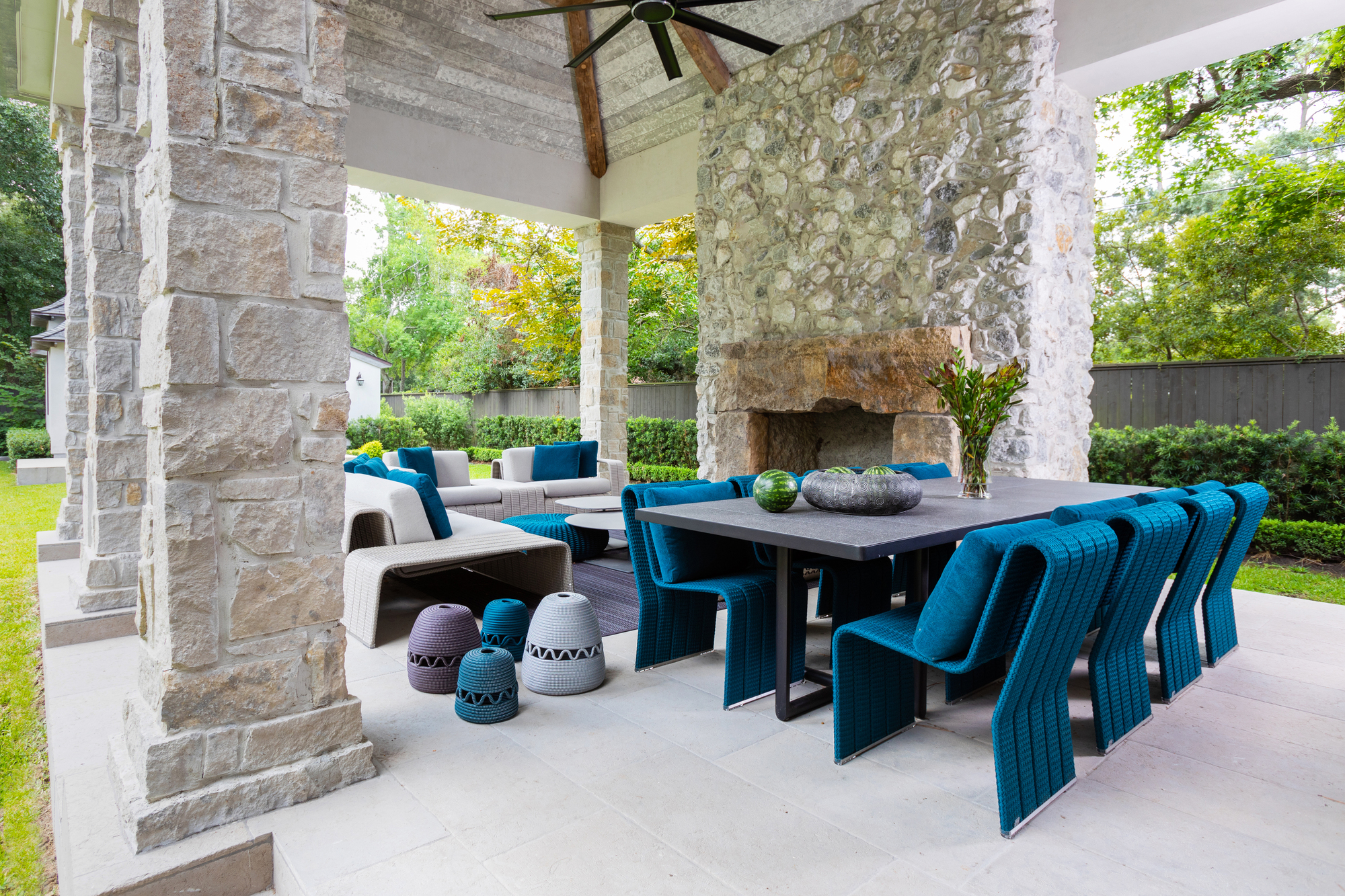
A firepit or fireplace adds warmth, extends the season, and makes everyone want to linger after dessert.
If space allows, a firepit — or better yet, a sculptural fireplace — can anchor the entire setup. “Not only does it provide warmth, but it also draws people in and encourages lingering long after dessert,” says Larry Walshe. Even a stone-clad outdoor bar or kitchen, he adds, “can lend gravitas and hospitality to the setting.”
Positioning matters. Firepits often require gas or electrical lines, so think practically — and keep smoke from blowing into the house.
Material and fuel are also design decisions. Concrete or stone feels grounded; metal leans industrial. Wood-burning has the atmosphere, but bio-ethanol is cleaner (though less warm). Choose based on what you care about more: ambiance or actual heat.
Some newer models double as tabletops or grills. “Some firepits have built-in grills so that you can enjoy an evening to its fullest without having to leave the table,” notes Jonny Brierley of Moda Furnishings. Which, frankly, is the point.
FAQs
Which Outdoor Dining Ideas Are Trending for 2025?
"In 2025, immersive outdoor dining is taking center stage,” says Grythyttan's Bo Hellberg. “This year, dining outdoors goes beyond traditional eating and more towards multi-sensory experiences that engage all the senses when dining al fresco, surrounded by greenery.”
Materials are shifting, too. “The use of natural wood — oak, pine, or teak, oiled or untreated — brings warmth and character to spaces, while steel adds a modern edge, offering durability and a sleek aesthetic that complements contemporary design,” Bo explains. The juxtaposition feels organic and fresh, but grounded.
Sustainability is also at the forefront. “Reclaimed woods, local materials, and seasonal planting to frame and support dining areas in a more meaningful way,” adds Larry Walshe.
And at the core of it all: comfort. Larry notes that it’s the little things — the cushions and integrated features within furniture — that really enhance the experience.
The details, as always, make the difference, but especially in 2025.
Now that you are, hopefully, filled with inspiration for your outdoor dining ideas, you might be interested in our favorite garden tables with chairs edit.

Formerly covering fashion at L’Officiel USA, style maven Julia Demer brings her love of design to Livingetc’s world of interiors. As the title’s New York-based Style Editor, Julia's work reflects a sharp eye for detail and an innate passion for aesthetics. Her journey began with a strong foundation in design, honing her craft at renowned establishments like The Row and even establishing her own eponymous fashion brand. Julia’s design background is evident in the way she thoughtfully curates shopping edits, always maintaining a focus on emerging trends while preserving timeless sensibilities. For Julia, fashion and interiors go hand in hand, reflecting her lifelong commitment to perfecting the art of style.



